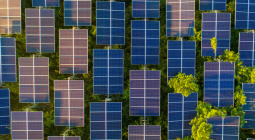IEA: Demand for renewables soar in wake of pandemic.

As consumption of other fuels decline, the International Energy Agency investigates how the uptake of renewable energy will fare as the global economy recovers from the Covid crisis.
2020 witnessed renewable sources such as solar and wind grow at their fastest rate in two decades and are set to continue this trend in the coming years. The growth in the United States and Europe, as well as India and Latin America, will accelerate much more than previously anticipated, compensating for China’s expected slowdown after immense 2020 growth.
The staggering extent of renewable energy capacity additions is expected to continue, with 270 GW to become operational in 2021, and 280 GW in 2022. This surge in production exceeds the record-level annual capacity additions of 2017-2019 by over 50%.
IEA’s Executive Director, Faith Birol, highlights that this is expected to account for 90% of total worldwide global power capacity increases in 2021 and 2022 as we strive to establish a “new normal” of energy production in the post-pandemic era.
Low investment costs and continuous policy support propels solar PV growth, which to an extent, compensates for the anticipated lower wind capacity additions in 2021-2022 (80 GW), owing partly to recent exceptional wind installations in China. Global solar PV expansion is set to reach 145 GW in 2021 and 162 GW in 2022, accounting for over 55% of total renewable energy expansion through to 2022.
Despite China’s dominance in renewable capacity growth, uncertainty remains due to the government’s decision to phase out subsidies for both wind and Solar PV projects towards the end of 2020, coupled with scepticism regarding the structure of their new incentive schemes to be announced at the end of 2021. Regardless, China’s Anticipated annual capacity additions remain significantly above the 2017-2019 average (+45% in 2021 and +58% in 2022) despite the expected decline in capacity additions by one quarter in 2021. New policy measures may culminate in growth in 2022 however, aligned with their ambitious long-term target of net-zero emissions by 2060.
Europe has become the second-largest renewable power market after China, and its annual capacity additions are forecast to increase 11% to 44 GW in 2021 and 49 GW in 2022. Such strong growth emanates from multiple countries extending their policies to meet the EU 2030 climate target, and by corporate power purchase agreement (PPA) markets booming in multiple countries.
The United States, renewable capacity growth is primarily driven by the extension of federal tax credits. Although the forecast does not consider the US administration’s new emissions reduction targets or its infrastructure bill which, if enacted, would drive a far great acceleration of renewable deployment after 2022.
Fatih Birol said: “Wind and solar power are giving us more reasons to be optimistic about our climate goals as they break record after record. Last year, the increase in renewable capacity accounted for 90% of the entire global power sector’s expansion.”
“Governments need to build on this promising momentum through policies that encourage greater investment in solar and wind, in the additional grid infrastructure they will require, and in other key renewable technologies such as hydropower, bioenergy and geothermal. A massive expansion of clean electricity is essential to giving the world a chance of achieving its net zero goals.’’
To read the full Renewable Energy Market Update 2021, click here.
May 2021
Climate Action





